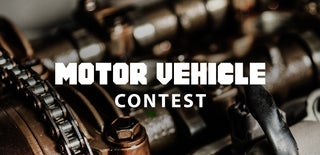Introduction: Totaled Civic Rebuild
Rebuilding a totaled car is no easy task. Between acquiring the replacement parts, removing damaged parts, realigning spaces, reforming structural frames, testing electronics, it can take some time and effort. Today I will walk you through the process of rebuilding my totaled 1993 Honda Civic Hatch. I use to work late shifts where I would be leaving work between 11 PM and 1 AM. On my way home one night, I was forced off the road by a cab driver making an illegal lane change, I swung to avoid hitting the cab and lost control and hit a wall at about 50mph. I was mostly unharmed, just a sprained thumb and I seemed to have bitten my tongue on impact. thanks to my seatbelt so ensure you always wear yours, you never know how your drive may end. I was surprised by the initial evaluation of the minimal damage due to the speed of impact and the fact that hitting a fixed object at even speeds of 30mph tends to do great damage, (or so I thought). Guess that goes to show how strong older cars were made. The car was undrivable so it was towed to where we would be working on it.
Supplies
- Various replacement parts
- Welding torch
- Jacks
- Replacement wiring
- Angle grinder
- Electronic saw
- Various sockets and wrenches
Step 1: Preliminary Damage Assessment
So we needed to determine the extent of the damage as usually what you can see isn't all that will need to be replaced or repaired. So we:
- Disconnect the battery before moving around any wires. This can also be done right after the accident.
- Start with moving any panels that will move freely.
- Jack the vehicle up and look on the underside for visible damage.
- Then remove any panels that you can that aren't wedged into one another.
After evaluating the damage, we could see excessive damage to the chassis and the bulkhead. The level of damage would make repairing these areas close to impossible without compromising the structural rigidity of the car. There didn't seem to be any damage to the engine or gearbox but we were about to find out that a frontal impact such as this will almost always cause damage to the engine of int located in the front of the vehicle.
Step 2: Removing the Engine
Removing the engine will take some time as things are not where there suppose to be.
- Put the vehicle on jack stands or a lift.
- Use a jack/hydraulic jack to open up spaces and separate crumpled metals to allow you to unbolt the engine.
- Unplug sensors, wiring, and hoses to allow more room to work and not put any stress on the wiring.
- Using an engine lift to remove the engine out once you have undone the bolts holding it in.
- With the engine removed you will be able to see any damage to the engine and within the engine bay.
With the engine out, we started to see the extent of the damage. 3 of the 4 engine mounts were broken and would need to be welded and rethread. The left side of the chassis was damaged all the way back to the firewall. This is where you'll have a good enough idea of what replacement parts are needed and start sourcing them.
Step 3: Sourcing Parts and Engine Repair
Now is a good time to source the replacement parts and do any engine repair needed. The parts needed for this repair were:
- Bonnet
- Front Bumper
- Nose Cut (Left chassis leg and bulkhead)
- Left Fender
- Headlights
- Radiator & Cooling fan
- AC compressor and condenser
- Engine mount bushing
- Inner and outer tie rod end
- Control arm
- Break cylinder
- Front Shock absorber and spring
- Wheel bearings
- Fender lining
- Radiator hoses
- Gaskets & bushings
- Replacement wiring
- Rubber spray sealant
- spray paint & primer
I took the engine and gearbox to a shop that did aluminum welding to repair the bolting holes for the engine mounts. I then changed the engine oil and gearbox fluid, the head gaskets and seals, timing belt, gearbox bushings.
Step 4: Removing Damaged Chassis
For this repair, we had to replace part of the chassis as it was beyond repair. The chassis leg was cut at the firewall using a power saw at the joint. The left chassis leg and the bulkhead were removed. If there is any straightening that needs to be done to the rest of the chassis, now is the time to do it. The right side of the chassis was bent and needed to be straightened with a hydraulic jack and hammer. When removing the portion of the chassis, ensure to leave a section on the firewall to attach the replacement part.
Step 5: Repairing Chassis
Now when it comes to welding the replacement part of the chassis to the vehicle, you will need to ensure the alignment and fitment are correct. First tack weld the chassis leg and bulkhead in place and check the alignment and fitment of the bumper, bonnet, headlights, fenders, wheels, fender linings. Ensure the fitment is as close as it should be and there are holes to secure all the parts that will be bolted back to it.
This section will take some time and a lot of test fitting to ensure the parts fit together properly. Once you are satisfied with the fitment, complete your welds. Weld along the seam lines. Once the chassis has been welded back together, sand down your welds to get them smooth and flush with the rest of the metalwork then coat the welds with a rubber spray sealant to prevent water from getting in and causing rust to weaken the welds.
Step 6: Engine Bay Cleanup & Engine Reinstall
Now its time to clean up the engine bay and the wires. I wanted to spray my engine bay, it should have been a shade of purple but seemed closer to pink after drying. I was ultimately satisfied with how it turned out.
Clean up the wires and connections, remove any dust from them and put them out of the way for reinstalling the engine. Carryover any switches, sensors, and bolts from the old section of the chassis to the one now installed.
Bolt-on any part you may have removed from the engine such as the starter, distributor etc. Lower your engine into the engine bay, test the fitment and spaces and bolt it in place.
Step 7: Connecting Electronics and Testing
We then connected all our engine sensors, throttle cable, bonnet latch, tightened the bolts. Then we went through the process of testing all the electronics, checking the dashboard lights, checking the headlights, blinkers, fuel lines, brake lines, adding coolant, etc. Then check for leaks or loose and unplugged wires and connect them before trying to start. Once we double checked everything, you can try to start the engine.
Depending on how long the vehicle was being worked on it may take some time to start. If there are issues starting, check the fuel lines, ignition, timing, ECU sensors, etc. It took about 4-5 minutes to get this one started. While it's up and running, check for leaks and unusual sounds. Don't rev the engine until it's up to temperature as its been sitting a while, it's good to let the fluids circulate before doing that.
Step 8: Preparing for Spray
Once the car is mechanically sound and driving as it should, its time to consider spraying the panels or the entire car. I wasn't able to spray this until 3-4 weeks after finishing the repairs and had to drive it so I decided to apply some primer to protect the bodywork and unify the look of the front. It was a simple primer application done in the driveway.
Step 9: Spray Time
I took my car to a local spray man as I don't have any experience in spraying. It took longer than expected and but after the masking, it was sprayed with 2 base coats and 1 clear coat. The spray shop technician did som minor bodywork adjustment and sanding.
Step 10: Wash, Clean & Drive
Finally, after around 4-5 months from the accident, she was done and got her first wash, inside and out. This repair taught me quite a bit and it's not something I would willingly do again easily as much as I love working on my car. It takes a lot of time and attention to detail and especially if you're doing most of the work on your own. I had a few friends helping along the way which I'm thankful for and it may have been cheaper to sell it and get something else but I love this car, as most guys tend to do their first car.

Runner Up in the
Motor Vehicle Contest













